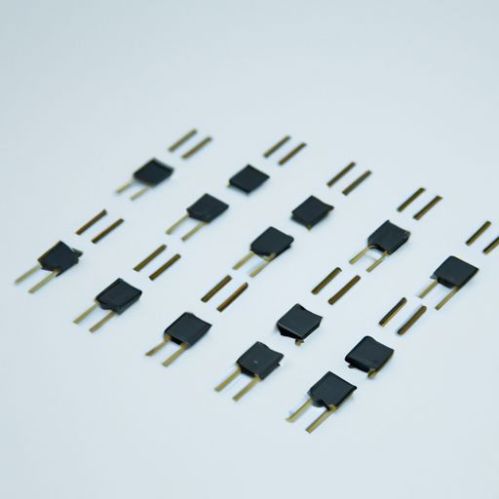Table of Contents
استكشاف دور الصمام الثنائي والترانزستورات وأجهزة الاستشعار في تصنيع الدوائر
الترانزستورات عبارة عن أجهزة شبه موصلة يمكنها تضخيم الإشارات الإلكترونية أو تبديلها. وهي تتكون من ثلاث طبقات من مادة أشباه الموصلات – الباعث والقاعدة والمجمع – ويمكن تصنيفها على أنها ترانزستورات توصيل ثنائية القطب (BJTs) أو ترانزستورات تأثير المجال (FETs). تُستخدم BJTs بشكل شائع في الدوائر التناظرية لتضخيم الإشارات، بينما تُفضل FETs في الدوائر الرقمية لعمليات التبديل. تعتبر الترانزستورات مكونات أساسية في مكبرات الصوت والمذبذبات والبوابات المنطقية، مما يتيح إنشاء أنظمة إلكترونية معقدة.
أجهزة الاستشعار هي أجهزة تكتشف التغيرات في البيئة وتحولها إلى إشارات كهربائية. يتم استخدامها في مجموعة واسعة من التطبيقات، بدءًا من استشعار درجة الحرارة والضغط وحتى اكتشاف الحركة والاستشعار عن قرب. يمكن تصنيف أجهزة الاستشعار على أساس الظاهرة الفيزيائية التي تقيسها، مثل أجهزة استشعار الضوء، وأجهزة استشعار درجة الحرارة، وأجهزة استشعار الحركة. إنها تلعب دورًا حاسمًا في تطبيقات الأتمتة والروبوتات وإنترنت الأشياء، مما يوفر بيانات في الوقت الفعلي لاتخاذ القرار والتحكم.
الدوائر المتكاملة (ICs) هي دوائر إلكترونية مصغرة تحتوي على مكونات متعددة، مثل الثنائيات والترانزستورات والمقاومات على شريحة واحدة من أشباه الموصلات. يتم استخدامها في كل الأجهزة الإلكترونية تقريبًا، بدءًا من الهواتف الذكية وأجهزة الكمبيوتر وحتى الأجهزة الطبية وأنظمة السيارات. يمكن أن تكون الدوائر المتكاملة عبارة عن إشارات تناظرية أو رقمية أو مختلطة، اعتمادًا على نوع الإشارات التي تعالجها. يتم تصنيعها باستخدام تقنيات تصنيع أشباه الموصلات، مثل الطباعة الحجرية الضوئية والحفر، لإنشاء أنماط دوائر معقدة على رقائق السيليكون.
المكثفات هي مكونات إلكترونية سلبية تقوم بتخزين وإطلاق الطاقة الكهربائية. وهي تتكون من لوحين موصلين تفصل بينهما مادة عازلة تعرف باسم المادة العازلة. تُستخدم المكثفات في تطبيقات التصفية والتنعيم وتخزين الطاقة، مما يوفر الاستقرار والموثوقية للدوائر الإلكترونية. وهي تأتي في أنواع مختلفة، مثل المكثفات الخزفية، والمكثفات الإلكتروليتية، ومكثفات التنتالوم، ولكل منها خصائص محددة لمتطلبات الدوائر المختلفة.
المقاومات هي مكونات إلكترونية سلبية تحد من تدفق التيار في الدائرة. يتم استخدامها لتقسيم الجهد، والحد من التيار، وتكييف الإشارة، وتوفير التحكم والحماية للأجهزة الإلكترونية. تتوفر المقاومات بقيم وتصنيفات طاقة مختلفة، مما يسمح للمصممين بتخصيص أداء الدائرة لتلبية متطلبات محددة. إنها ضرورية لتحديد نقاط التحيز، والتحكم في الكسب، وحماية المكونات من التيارات الزائدة.
في الختام، تعد الثنائيات والترانزستورات وأجهزة الاستشعار مكونات أساسية في تصنيع الدوائر، مما يتيح إنشاء أنظمة إلكترونية معقدة لمختلف التطبيقات. تعمل الدوائر المتكاملة والمكثفات والمقاومات مع هذه المكونات لتوفير الوظائف والموثوقية والأداء للأجهزة الإلكترونية. إن فهم دور هذه المكونات أمر بالغ الأهمية لتصميم وبناء الدوائر التي تلبي متطلبات التكنولوجيا الحديثة.

Transistors are semiconductor devices that can amplify or switch electronic signals. They consist of three layers of semiconductor material – the emitter, base, and collector – and can be classified as bipolar junction transistors (BJTs) or field-effect transistors (FETs). BJTs are commonly used in analog circuits for amplifying signals, while FETs are preferred in digital circuits for switching operations. Transistors are essential components in amplifiers, Oscillators, and logic Gates, enabling the creation of complex electronic systems.
Sensors are devices that detect changes in the Environment and convert them into electrical signals. They are used in a wide range of applications, from temperature and pressure sensing to motion detection and proximity sensing. Sensors can be classified based on the physical phenomenon they measure, such as light sensors, Temperature Sensors, and motion sensors. They play a crucial role in automation, robotics, and IoT (Internet of Things) applications, providing real-time data for decision-making and control.
Integrated Circuits (ICs) are miniature electronic circuits that contain multiple components, such as Diodes, transistors, and Resistors, on a single semiconductor chip. They are used in almost every electronic device, from smartphones and computers to medical devices and automotive systems. ICs can be analog, digital, or mixed-signal, depending on the type of signals they process. They are manufactured using semiconductor fabrication techniques, such as photolithography and etching, to create complex circuit patterns on silicon wafers.
Capacitors are passive electronic components that store and release electrical energy. They consist of two conductive plates separated by an insulating material, known as a dielectric. Capacitors are used in filtering, smoothing, and energy storage applications, providing stability and reliability to electronic circuits. They come in various types, such as ceramic capacitors, electrolytic capacitors, and tantalum capacitors, each with specific characteristics for different circuit requirements.
Resistors are passive electronic components that limit the flow of current in a circuit. They are used for voltage division, current limiting, and signal conditioning, providing control and protection to electronic devices. Resistors are available in different values and power ratings, allowing designers to tailor the circuit performance to meet specific requirements. They are essential for setting bias points, controlling gain, and protecting components from excessive currents.
In conclusion, diodes, transistors, and sensors are essential components in circuit manufacturing, enabling the creation of complex electronic systems for various applications. Integrated circuits, capacitors, and resistors work together with these components to provide functionality, reliability, and performance to electronic devices. Understanding the role of these components is crucial for designing and building circuits that meet the demands of modern technology.
